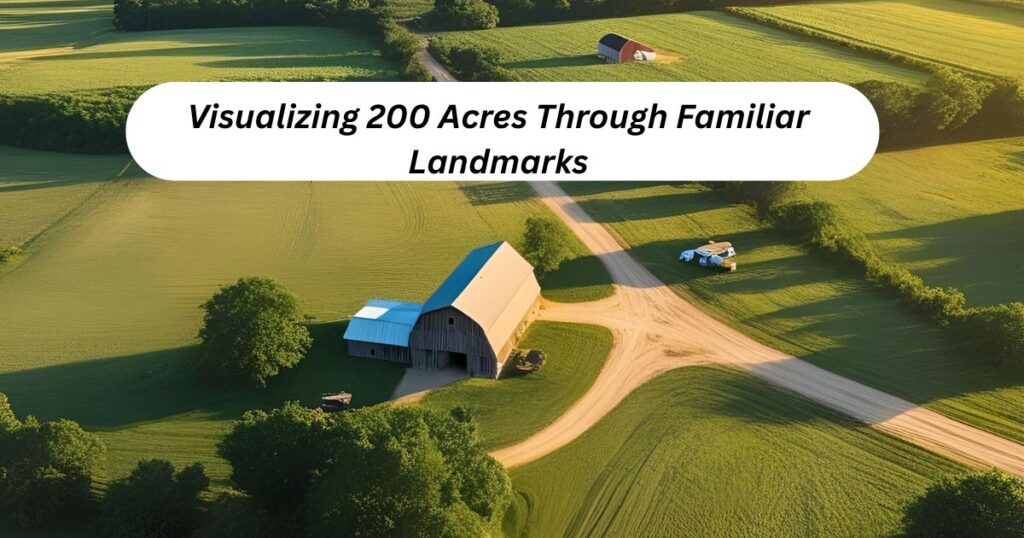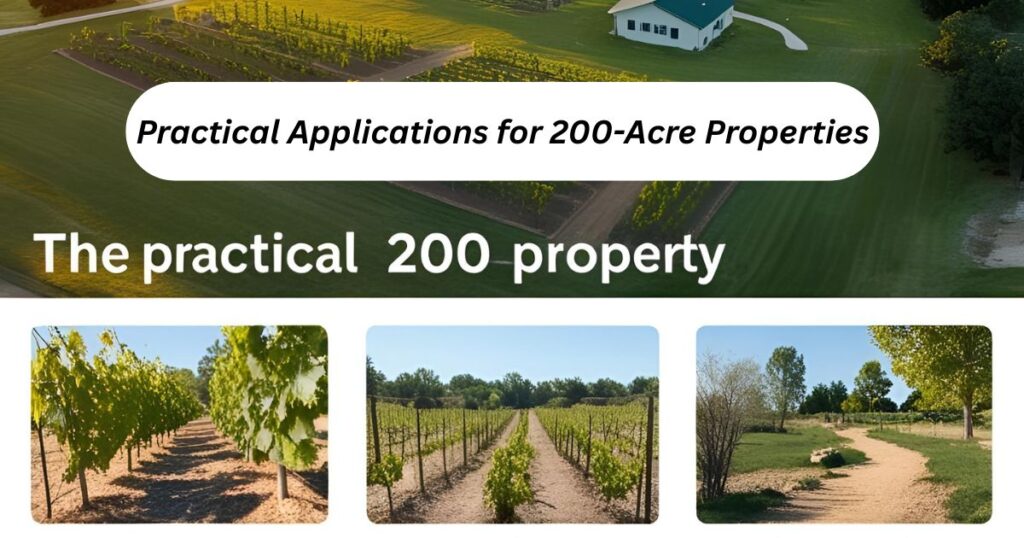Understanding the true scale of 200 acres can be challenging without proper reference points. Whether you’re considering a real estate development, planning an agricultural operation, or simply curious about land measurements, this comprehensive guide will help you visualize exactly how much space 200 acres encompasses through familiar landmarks and everyday objects.
Understanding Land Measurement Fundamentals
Before exploring comparisons, it’s essential to establish what an acre actually represents in measurable terms. One acre equals 43,560 square feet of land area. Therefore, 200 acres translates to an impressive 8,712,000 square feet of space—a truly substantial area with tremendous development potential.
Professional land developers, urban planners, and agricultural specialists rely on acreage measurements to quantify large land parcels effectively. Understanding the scale of 200 acres helps property investors, developers, and landowners make informed decisions about utilization strategies and development opportunities.
“Visualizing large land areas through familiar comparisons provides crucial context for effective planning and development decisions.”
Visualizing 200 Acres Through Familiar Landmarks

3X The American Dream Mall
The American Dream Mall in New Jersey spans approximately 69 acres and represents one of North America’s largest retail developments. A 200-acre parcel could accommodate three of these massive structures with room to spare. This comparison illustrates the extraordinary scale available for commercial land development on such a property.
40X Central Park’s Great Lawn
Central Park’s Great Lawn in New York City spans approximately 5 acres. Within 200 acres, you could fit 40 such expansive green spaces. This reference point is particularly valuable for landscape architecture and urban planning professionals considering the integration of significant public recreational areas within larger developments.
8X Disneyland’s Original Park
The original Disneyland Park in Anaheim occupies roughly 25 acres of developed entertainment space. Within 200 acres, you could fit eight complete theme parks of comparable size—a striking visualization of this land area’s potential for large-scale tourism and leisure venues.
56X A Standard Running Track
A standard running track, including its infield area, occupies approximately 3.57 acres. A 200-acre property could contain 56 complete track facilities, illustrating its potential for comprehensive sports facility planning and recreational facility development.
133X A Soccer Field
A standard soccer field requires about 1.5 acres of space. Within 200 acres, you could accommodate 133 full-sized soccer fields—enough to host multiple simultaneous tournaments with substantial spectator facilities. This comparison resonates particularly well with sports complex acreage planning.
25X The National 9/11 Memorial Plaza
The National 9/11 Memorial Plaza occupies 8 acres of sacred space in Manhattan. A 200-acre property could contain 25 memorial sites of comparable size, illustrating the potential for creating significant commemorative spaces within larger urban planning projects.
3X The King of Prussia Mall
At 66 acres, the King of Prussia Mall ranks among America’s largest shopping centers. A 200-acre property could contain three complete facilities of this magnitude, demonstrating the remarkable potential for retail spaces development and commercial land size planning.
26X The Lincoln Memorial Reflecting Pool
The iconic Lincoln Memorial Reflecting Pool spans approximately 7.5 acres. Within 200 acres, you could fit 26 pools of similar magnitude—a powerful visualization for landscape architects and public space planners working on significant urban park initiatives.
151X An American Football Field
A regulation American football field, including end zones, covers approximately 1.32 acres. You would need to place 151 such fields side by side to visualize 200 acres—an excellent reference point for sports enthusiasts and sports facility planning professionals.
100X A Typical High School Campus
A standard high school campus, including buildings, athletic fields, and parking areas, typically requires about 2 acres. Within 200 acres, you could establish 100 educational facilities of this size—a compelling comparison for understanding educational facility planning capacity.
4X The Grand Central Station
Grand Central Station in New York City encompasses 48 acres of transportation infrastructure and commercial space. Four facilities of this scale could operate within a 200-acre development, demonstrating the potential for major transit center and commercial hubs through effective transportation planning.
512X A Hockey Rink
A regulation hockey rink measures 200 feet by 85 feet, covering about 0.39 acres. Remarkably, 512 such rinks could fit within 200 acres, demonstrating the extraordinary capacity of this land area for sports facility planning and recreational facility development.
1,853X A Basketball Court
A standard basketball court occupies approximately 0.11 acres. The ability to fit 1,853 courts within 200 acres provides a striking visualization of this land area’s tremendous scale for sports complex acreage planning.
400X A Single-family House
The typical single-family house property occupies approximately 0.5 acres. A 200-acre parcel could accommodate 400 such homes, providing an accessible reference point for residential community land development potential.
647X An Olympic-sized Swimming Pool
An Olympic-sized swimming pool occupies roughly 0.31 acres. A 200-acre development could incorporate 647 of these impressive aquatic facilities—an extraordinary number that helps conceptualize this land area’s vast potential for recreational land usage.
12X The Shops at Columbus Circle
The Shops at Columbus Circle in New York City occupies approximately 17 acres of premium retail space. A 200-acre development could incorporate twelve such upscale shopping centers, highlighting the capacity for creating multiple high-end commercial districts.
Essential Measurement Conversions for 200 Acres
For additional perspective, consider 200 acres expressed in alternative measurement units:
| Unit | Equivalent Measurement |
| Square Feet | 8,712,000 ft² |
| Square Meters | 809,371 m² |
| Square Kilometers | 0.809 km² |
| Square Miles | 0.3125 mi² |
| Hectares | 80.94 ha |
| Yards (square) | 968,000 yd² |
These conversions help provide additional context for understanding the scale of 200 acres, particularly for those more familiar with metric or alternative measurement units.
Practical Applications for 200-Acre Properties

Agricultural Operations: Maximizing Production Potential
For agricultural enterprises, 200 acres represents substantial production capacity with significant potential for diverse farming operations. Such a property could support extensive agricultural planning initiatives including:
Large-scale crop cultivation operations across multiple fields, allowing for crop rotation and diverse production systems. The space provides ample room for implementing modern precision farming techniques with efficient equipment utilization.
Extensive livestock grazing areas with proper rotational management systems can be established, supporting sustainable animal husbandry practices. The size allows for proper separation of different livestock groups while maintaining healthy pasture conditions.
Diversified farming systems with multiple production zones can be implemented, creating integrated agricultural ecosystems that maximize production while minimizing environmental impact. This approach supports sustainable land planning through complementary agricultural activities.
200 acres provides sufficient space for implementing comprehensive agricultural land area management systems that balance production goals with conservation objectives. Many successful family farms operate at this scale with substantial productive capacity.
Real Estate Development: Creating Comprehensive Communities
From a real estate acreage comparison perspective, 200 acres offers remarkable flexibility for creating substantial developments:
Master-planned residential communities with hundreds of homes can be established, providing diverse housing options within a cohesive neighborhood design. Such developments typically incorporate significant community amenities and infrastructure.
Mixed-use developments incorporating residential, commercial, and recreational components can be created, supporting vibrant, walkable communities that reduce transportation needs. These developments represent modern approaches to community development.
Corporate campus developments with extensive office space and supporting facilities can be accommodated, providing significant employment centers with proper amenities. Such facilities often incorporate substantial green space and recreational opportunities.
200 acres provides sufficient space for proper infrastructure development, including road networks, utility systems, and community facilities. This scale supports comprehensive land development project scale planning with proper attention to all necessary components.
Environmental Conservation: Establishing Meaningful Ecological Reserves
For environmental conservation initiatives, 200 acres provides significant ecological value with substantial impact potential:
Nature preserves protecting critical habitats can be established, supporting biodiversity conservation efforts at a meaningful scale. Such reserves can protect vulnerable ecosystems and provide habitat for numerous plant and animal species.
Wildlife corridors connecting larger ecological systems can be created, facilitating animal movement and genetic exchange between populations. These corridors represent crucial components of regional conservation strategies.
Wetland restoration projects can be implemented at a significant scale, supporting water filtration, flood mitigation, and habitat creation functions. Such projects provide substantial ecological services while enhancing environmental quality.
200 acres allows for comprehensive ecological management incorporating diverse habitat types and conservation approaches. This scale supports meaningful conservation outcomes with substantial ecological impact potential.
Sustainable Development: Implementing Future-Focused Planning Strategies
Modern land development increasingly incorporates sustainable design principles, which 200 acres readily accommodates:
Integration of green spaces throughout development areas supports ecological functions while enhancing community aesthetics and recreational opportunities. Such approaches represent best practices in modern urban planning.
Implementation of renewable energy systems at scale can be achieved, supporting sustainability goals through clean energy production. Solar arrays, wind installations, or biomass facilities can be incorporated into overall development plans.
Development of walkable communities with reduced transportation requirements supports climate goals while enhancing quality of life. Such designs represent forward-thinking approaches to community development and urban planning.
200 acres provides sufficient space for implementing comprehensive water management systems, including retention ponds, natural filtration areas, and sustainable drainage approaches. These systems support environmental quality while reducing infrastructure costs.
Conclusion: Unlocking the Potential of 200 Acres
Understanding the true scale of 200 acres through familiar comparisons helps property owners, developers, and planners visualize the extraordinary potential of such a land area. Whether viewed in terms of commercial developments, recreational facilities, public spaces, or residential communities, 200 acres represents a substantial canvas for creating significant and impactful projects.
As land development project scale considerations continue to evolve, properties of this size offer remarkable opportunities for balancing development needs with environmental stewardship. By conceptualizing 200 acres through tangible comparisons to familiar landmarks like the American Dream Mall, Central Park’s Great Lawn, or Disneyland, stakeholders can better appreciate the tremendous possibilities this land area presents.
The versatility of 200 acres supports diverse applications from agricultural planning to real estate development and environmental conservation, making it an extremely valuable land resource. With proper planning and sustainable approaches, such properties can create lasting value while meeting modern development standards and community needs.











